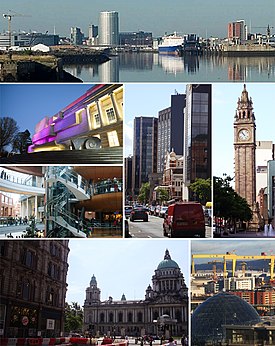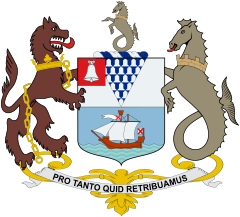Belfast
| Belfast | |
|---|---|
 Skyline and buildings throughout the City of Belfast |
|
 Coat of arms with motto "Pro Tanto Quid Retribuamus" (Latin: "what shall we give in return for so much") |
|
| Belfast shown within Northern Ireland | |
| Area | 44.4 sq mi (115 km2) |
| Population | City of Belfast: 333,000 (2014) Urban Area: 483,418 (2001) Metropolitan area: 585,996 (2001) |
| Irish grid reference | J338740 |
| District | |
| Country | Northern Ireland |
| Sovereign state | United Kingdom |
| Post town | BELFAST |
| Postcode district | BT1–BT17, BT29 (part), BT36 (part), BT58 |
| Dialling code | 028 |
| Police | Northern Ireland |
| Fire | Northern Ireland |
| Ambulance | Northern Ireland |
| EU Parliament | Northern Ireland |
| UK Parliament | |
| NI Assembly | |
| Website | www.belfastcity.gov.uk |
Belfast (/ˈbɛl.fɑːst/ or /ˈbɛl.fæst/; from Irish: Béal Feirste, meaning "rivermouth of the sandbanks") is the capital and largest city of Northern Ireland, the second largest on the island of Ireland, and the heart of the tenth largest Primary Urban Area in the United Kingdom. On the River Lagan, it had a population of 286,000 at the 2011 census and 333,871 after the 2015 council reform. Belfast was granted city status in 1888.
Belfast was a centre of the Irish linen, tobacco processing, rope-making and shipbuilding industries: in the early 20th century, Harland and Wolff, which built the RMS Titanic, was the world's biggest and most productive shipyard. Belfast played a key role in the Industrial Revolution, and was a global industrial centre until the latter half of the 20th century. It has sustained a major aerospace and missiles industry since the mid 1930s. Industrialisation and the inward migration it brought made Belfast Ireland's biggest city at the beginning of the 20th century.
...
Wikipedia

